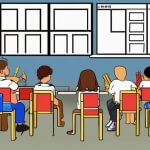Standardized Testing: A Useful Or Misused Tool?

Yes To The Test, But…
According to education researcher Yvonne Kao, standardized testing should not be abandoned by education specialists because it “is necessary to measure and compare certain types of educational attainment across socially and geographically disparate populations.”
However, Kao believes that standardized testing is being misused and is in need of substantial reforming. “Leaving aside issues about states gaming the system or rampant cheating in individual districts, the fundamental problem with standardized testing today is the tests are being used for all kinds of purposes that they are not well-suited for,” Kao explained.
“Standardized tests are summative assessments — tests to determine if students have reached a particular level of academic achievement at a particular point in time. … Standardized tests do not give teachers and administrators much information they can use to improve teaching and learning at the school.”
Kao points out that, while educators get composite scores along with subscores for each tested area, “simply telling a teacher that the students are terrible in the number sense … Is of limited help.”
“In order to improve teaching and learning, a teacher needs to know what types of errors the students are making,” Kao said. “Furthermore, the information comes too late (at the very end of the school year, and in some states, not until mid-August), so the test scores aren’t even used to make decisions about grade retention to help the kids who didn’t do well on that topic.”
For Kao, the interpretation of standardized test results lacks a straightforwardness that is necessary to empower an educator’s teaching decisions. “While it is true that a school with high failing percentages is not promoting much learning, the converse is not necessarily true.”
“In my state, the content of the tests is extremely predictable. In some districts I have worked with, they have predicting the test content down to a science, devoting six to nine weeks to benchmark and practice testing, after which the teachers are presented with a detailed item analysis that describes which problem types the students are likely to fail. The teachers then drill those problem types. I have worked with schools with ‘proficiency’ rates upwards of 90 percent, but where the fourth-graders could not do single-digit multiplication. I have also seen cases where high proficiency rates lull administrators into complacency — because 98 percent of the students passed the tests, they are doing fine and do not have to evaluate or improve anything else.”
How We Define Standardized Testing Needs To Change
Education specialist Jason Becker quotes the following from author Daniel Koretz’s Measuring Up: “It [standardized testing] means only that the test is uniform. Specifically, it means only that all examinees face the same tasks, administered in the same manner, and scored in the same way. The motivation for standardization is simple: to avoid irrelevant factors that might distort comparisons among individuals.”
Becker feels that we should “absolutely not” did ourselves of this educational tool. “That’s ridiculous. In fact, most form of measurement which has any kind of stakes attached are standardized. This includes the in-class essay you wrote in your social studies class that everyone took while in school over one period that was graded with a rubric.”
Becker continued: “The separate, more interesting questions [are]: ‘What are the limitations of standardization when determining educational achievement? When is it okay not to standardize an assessment? What are the appropriate uses for large-scale, summative assessments in decision-making processes? What are the limitations of current large-scale, summative assessments and is it technically possible to address these limitations with new and better assessments?'”
We Expect Tests To Do All The Heavy Lifting
Becker is right to challenge haters of the test to think of a different, better way to address the issues that standardized tests cover. To this, Kao believes, “The education and research communities need to develop an entire portfolio of assessments that can be used for school and teacher accountability.”
“Standardized tests can play an important role as a quantitative baseline or ‘sanity check’ measure … But that portfolio should include some more subjective measures of teaching and learning, like teacher observations or student project portfolios, and also some other types of school performance/school management measures.”
“In school evaluation — as in all kids of research — it is good to see multiple types of evidence converging on the same conclusion,” Kao said. “Relying mainly on standardized testing for school accountability is going to skew our understanding of what is happening.”
Educator Betsy Weigle, a contributor at Teachers.net, feels that standardized tests are on the right track, approving “In defiance of nearly every teacher I know or have ever known….”
“Something tells me that testing, both formal and informal, is here to stay. We just haven’t come up with a better way to fairly evaluate proficiency,” Weigle said. “Everyone will be tested at some point — literally, ‘number-two-pencil’ tested, not just ‘life-is-hard’ tested — and best teaching practices must ensure that students are ready for this challenge.”
Standardized Testing Is Great For Credentials
Peter Scheyer, educational contributor at Quora sees standardized testing as a more useful tool for credentialing rather than education.
“A credential has more value when more people understand what it means,” Scheyer said. “Using a non-standardized test automatically means that the test is less valuable to people who are not experts in the field.”
To illustrate his point, Scheyer uses a hypothetical. “You are a budding Picasso who wants to pursue your art. However, you are from a disadvantaged situation and can’t afford to attend art school. It is very difficult to prove that you are worthy of scholarship, or even admission, among peers who can spend more time and effort on grooming and traveling, applications and honing your art, because there is a distinct lack of a standardized test for artistic ability. This could be for many reasons, but for the purpose of our hypothetical the fact is enough.”
“Contrast this with a math or physics prodigy. Due to these fields having clear standards and testing mechanisms, you will be identified as a standout extremely early in life, and you will be eligible for many scholarships and special education programs based on your test scores. It will even be easier to convince potential sponsors to be your patrons, because a larger pool of patrons will be able to compare you more quickly with age-peers and see how outstanding you are.”
Scheyer continued: “The short version of this argument is, abandon standardized testing in favor of what? And how could a lack of standardized tests benefit students, considering that the quantification of students through standardized tests is the mechanism by which excellence can be recognized, as well as weakness improved, in fields regarded as valuable by the entities which fund schooling?”
What’s Wrong With Standardized Testing: The Nitty Gritty
While Scheyer was definitely in no hurry to rid the education system of standardized testing, he did see the limitations, pointing out that it often results in “only learning things that fit into existing standardized frameworks, and then only to metrics set as averages across the entire population, which screws the excellent students and encourages mediocrity in the rest!”
He encourages the following “fixes” to the system:
1. Standardized testing requires that students conform to existing standardized fields and frameworks!
“Education could expand standardized testing into new fields (art, music, literature, English composition, etc), understanding that each student’s unique makeup is worth specialized support, and encouraging each student’s particular excellences while encouraging only mediocrity in ‘core skills,'” Scheyer said. “Standardized testing can easily be applied to fine arts, but honestly no one has really tried, except in historical aspects. This is due to no one wanting to stand out and say, ‘This is art, nothing else is art. If you do those other things you fail at art.’ Art, as the expression of creativity, is widely considered to be incomprehensible, yes, the direct opposite of standardized testing. However, the information collected by standardized tests gives a range of normal answers. It confers equal information to get a 0 percent on a 1,000,000 question test as it does to get 100 percent. With either one you need to know all of the correct answers to overcome the margins of error and achieve your standout score.”
2. Kids are only learning to metrics set as averages across the entire population!
Scheyer brings mention of the failures of the No Child Left Behind Act here, which “united everyone who had children going through schools hamstrung by it in hatred of it.”
“I’ll be more brief in addressing this one: there is no need to average children and then use all available funding to improve the worst performers, while ignoring the best. This is failed standardization at its worst, promoting mediocrity at the expense of excellence. Attempting to ensure that all educated children reach a mediocre benchmark may, perhaps at worst, result in success. How to fix it without removing standardized testing? Simple: repealment of the act, or expansion of it to include the above metrics for creativity and ‘weirdness.’ Either would do a great job of addressing the issue.”
3. Excellent students are being screwed, and only mediocrity is encouraged in the rest!
Scheyer points out that this logic has a built-in fallacy — that all students are either excellent or mediocre, at best.
“A much wider set of standardized tests, including in each the potential for weirdness using the above techniques, shows the wide variety of skill and aptitude in any tested population,” Scheyer explains. “My suggestion for this is that students who perform well on weirdness in any category be encouraged into that, and that students who perform well in normal fashions be encouraged in those areas, via less structured classwork in which every teacher teaches those who come into their classroom in a collegiate fashion — basic lectures, advanced students assisting lower students in performing on area-specific standardized tests, and advanced students also pursuing their own studies more directly under the teacher.”
Scheyer says that expansion of educational fields of study to include this ‘weirdness,’ or subjective subjects, would mean that standardized testing “would do much to ensure excellence is rewarded in fields apart from specialties, encourage a mediocre level of understanding in all students, and allow students doing poorly to actively subvert the fields of difficulty,” the latter of which he calls “a historically attractive choice for students of excellence and mediocrity alike.”
In Summary
It’s hard not to agree with these contributors on standardized testing and its importance to the future of education. While the wrong emphasis is currently being placed upon it, there needs to be some clear standard for measuring and encouraging excellence, rather than simply bringing all students to a standard of mediocrity. That’s certainly no way to make waves in the ocean of global education.
What tweaks, if any, do you think should be made to the current standardized testing system? Does the US place too much importance on it, or does it simply misuse an otherwise useful tool for determining adequate learning benchmarks? Share your thoughts with us below!
[Image via Empower Magazine]









Ultimately, standardized tests are one of the primary contributors to failure seen within the modern education system. Such tests cater to only a select few of students. School administrators, on the other hand, receive the most benefits. This is due to the higher-ups gaining leverage over how teachers teach – whether it be control of the material, classwork, etc. Such acts ensure that students all over the world regardless of individual learning style will be taught the same identical way. This way of thinking is due to the idea that if people learn the same material, they will all be intelligent. As results have shown, however, that is not the case.
If standardized tests could be utilized less often, there would be a drastic positive increase in students’ scores and behavior. The system would also be balanced making it fair for all students. Now, this is not to say that the material should be diluted for students who need and can handle a challenge. Instead, the tests should be distributed to students depending on their own personal ability. Administrations claim to do this now, and some may very well do it, but the majority results in schools utilizing the No Child Left Behind policy. What many individuals are now realizing is that such a law holds all children back from reaching their true potential. Such an action is how an education system fails.
Overall, serious changes need to be implemented. Modern school cannot and will not be able to proceed in the manner that it is currently going. Students and teachers will continue to be affected by the negative impacts which will result in one of two ways: An academic revolution or eradication of school entirely. Steps towards changes need to be taken, but such steps must first be done so by the higher-ups of education.
Standardized testing is used as a method of comparison among upperclassmen across the nation to assess the individual, school, district, state, and nationally. The test scores are reliable. The teachers and students are held accountable for teaching and learning , respectively. From standardized testing arise many different issues like questioning pay for performance, the frequency of the testing, the teaching the test issue, and many more. Colleges also look at other factors besides the big standardized tests like the ACTs and SATs , but it is one of the greatest factors. A high test score is often of more value than a high GPA.
This was a rather comprehensive blog and I appreciate very much the thought and background put into it, but please check your work, it was very hard to read and your blog really could use a grammar check.
Many teachers find themselves planning their instruction based on a standardized test or a test for their own evaluation, such as their SLO. This is because their performance evaluation, their job, and their reputation in their school heavily relies on how their students score on these various high stakes assessments. Because teachers feel the pressure to make sure their students do well on testing, they run out of time to be sure to cover all important concepts that students would benefit from learning. They begin teaching to the test rather than teaching to the standards. In addition, there is less time to make learning fun and to use student interests when planning for instruction if it does not align with expectations for testing. Due to this stressful teaching and learning environment, teacher burnout rates are increasing. Not being able to teach students what you think is important or being able to make instruction meaningful for them takes away the passion most teachers have for this profession. This issue is also important because students are not getting the most out of their learning experiences at school when testing is the focus of most of their instruction.
I completely agree! Students should not be tested as often as they do. Especially not at such a young age as elementary students. These students who consistently fail are setup and have the mindset that they will always fail. They are given four or five choices and are told that only one answer is correct. This tells them that everything in life has four or five choices but one correct thing. This is not true in life.
These tests don’t measure the progress of a student, they only measure how a student is doing in one specific moment in time. They can either be having a good day or a bad day and not be focused during the exam.
I wrote an article discussing my view points on testing with specific students on my website. In this, I dive further into the above topics and discuss how they affect the child.
http://www.educationandtheenvironment.com/blog/students-with-asd
Here’s three suggestions. (1) Tests should not be administered by a commercial entity. Privatized and commercialized testing is the single biggest impediment to improvement. (2) Test less often. There is absolutely no reason why standardized tests needs to occur yearly – that is the purview of schools, not outside entities who are more interested in profiting from the testing frequency. (3) Stop relying so much on multiple-choice and easily quantified testing. A student’s aptitude cannot simply be synthesized into a number. This only serves to segregate those who have broader (i.e. outside-the-box) intelligence.
It baffles the mind how there is so much evidence against standardized testing and quantified results, and yet year after year as the evidence mounts, nothing changes. This can only be because vested and commercial interests have too much of an influence. They keep the model from changing and evolving with time and the needs of society. While this moribund dependence on quantifying aptitude may be congruent with a for-profit model (think ROI calculations for the yearly stock report), it will discard those students most capable of solving the most complex problems of tomorrow.